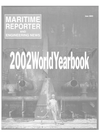
MAN B&W Turbocharger Technology Unveiled
This past May marked the unveiling of an ocean-going product deep in the heart of Bavaria, specifically at the lake at Ammersee near Munich, where MAN B&W presented its newest engine series — the TCA (Turbocharger Axial).
Encompassing two years of research and development, the first production turbocharger, the TCA77, has entered into service with an MAN B&W 7S50MC-C two-stroke diesel engine.
With the TCA77 being first production turbocharger form this series, the new turbocharger development combines a radial-flow compressor wheel with axial-flow turbine blading.
In addition, frame sizes ranging from the TCA33 — all the way up to the TCA99 — are currently in development.
So this broad range can be covered, the new turbocharger is of modular design - meaning that air is sucked in either via an air intake silencer, a 90-degree intake casing or an intake manifold. The exhaust gas from the combustion process then flows into the turbine via either an axial- or a radial flow casing.
The new TCA series also features the proven separate-casing-base concept from the NA series, thus making it adaptable to the turbocharging requirements of the application in question.
The intake air is compressed by the compressor wheel, which is driven by the turbine. Both the compressor wheel and the turbine can then be adjusted to engine requirements by selecting from a range of meridians and blading configurations.
Diffusers and nozzle rings, which are finely-shaped in their mass-flow areas allow the turbochargers to be fine-tuned to the engine. To achieve maximum variability, an optional nozzle ring capable of adjustment during operation will be available in the near future.
All TCA turbochargers also come equipped with a minimum of external connections. The TCAs are also equipped with hot casing components with a new temperature and noisereducing casing with a sturdy sheetmetal cover. This casing significantly lowers the risk of engine-room personnel becoming injured by coming into contact with excessively hot surfaces in installations where the turbocharger is accessible. None of the TCA tur- bocharger bearing casings is water cooled - not even in the largest frame sizes - the TCA88 and TCA99. The heat brought in by the compressor and the turbine is dissipated in the luboil flung off the shaft of the rotating assembly.
The oil mist thus generated can drop down the walls of the generously- dimensioned interior of the bearing casing, thereby evenly absorbing the heat, which is to be dissipated.
Circle 18 on Reader Service Card www.maritimereporterinfo.com
Other stories from June 2002 issue
Content
- Bollinger To Acquire Halter Marine page: 6
- Bidding War Comes to an End page: 6
- Jotun And NOF Marine Coatings Join Forces page: 8
- Thunder Horse Will Get Wartsila Generators page: 10
- United Defense to Acquire United States Marine Repair page: 10
- New Order For MAN B&W Diesel ME-Engines page: 12
- Fares Al Salam Parts The Red Sea page: 14
- Redundancy The Next Watchword? page: 20
- Cargo Handling's New Force page: 22
- A Naval Architect's Look At Design Trends page: 24
- Conoco Leads The Way For GOM Shuttle Tankers page: 27
- Daewoo Shipbuilding To Build, Refit LNGs For Exmar page: 27
- Navy League Comes to NY for Centennial Celebration page: 28
- Prospects Abound, But Where's the Money? page: 32
- OPA '90 - The Oil Pollution Act of 1990 page: 33
- Container & RoRo Tonnage — Non-Contiguous Liner Trades page: 35
- Matson Signs $220M Contract With Kvaerner Philadelphia page: 38
- GL: Exporting German Precision page: 40
- World Shipbuilding to Fall Slightly page: 44
- Tanker Market is Solid page: 45
- Bergesen Releases 1Q Results page: 46
- OMI Announces 1Q Results page: 47
- MAN B&W Turbocharger Technology Unveiled page: 49
- Answering the Call from Above page: 50
- Thrane & Thrane Offers Capsat Fleet77 page: 53
- Crisis Management and the Integration of Vessel Tracking Technologies page: 60
- Rear Admiral Pluta Redefines Maritime Security page: 64
- Ship Graveyard page: 68
- Intertanko's Sustainable Challenge page: 72
- German Barging: Over the Divide page: 76
- Blohm+Voss: 125 Years Young page: 80
- Thordon Makes Inroads With COMPAC Shaft Bearing page: 90
- Halifax Lays Keel For First of Two OSV's page: 91
- Owners Approve White Rose Oilfield page: 91
- Voyage Data Recorders page: 92
- Titan Re-Floats IMaersk La Guaira page: 96
- Austal USA Enters Repair Market page: 96
- Maritime Industry Remembers Nealis page: 97

